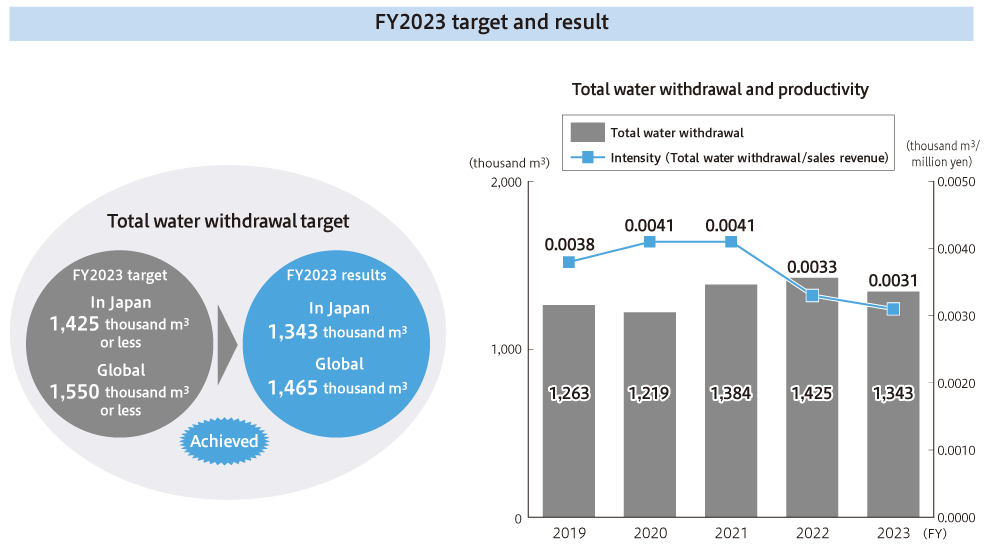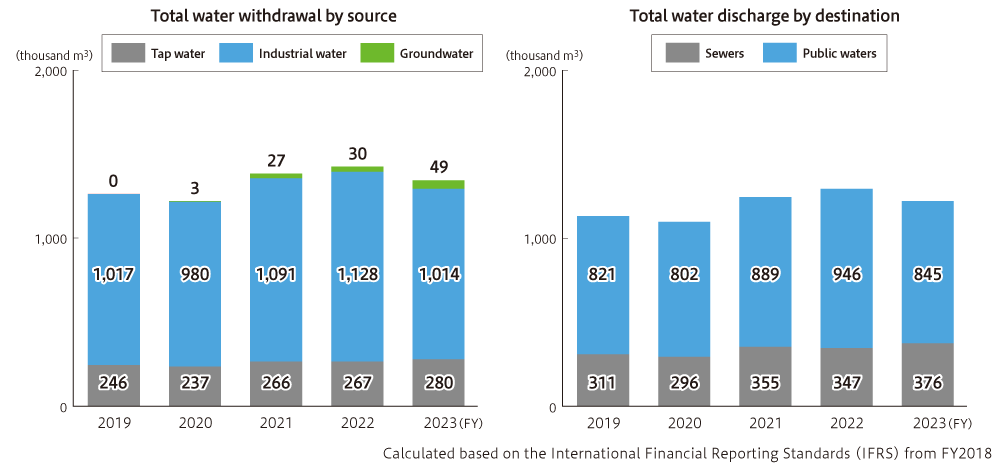Water
Targets and Results
Medium- and long-term targets


Water Initiatives
Establishment of new medium- and long-term targets
*2 Actual results for the new targets will be published from FY2025 based on the results of the FY2024 survey.
Visualization of water consumption
Pharmaceuticals in the Environment
Pharmaceuticals released into the environment are drawing an increasing amount of attention, as attested to by the report on Pharmaceuticals in the Environment (PiE)*3 published by the Organization for Economic Cooperation and Development (OECD). To responsibly utilize water during the pharmaceutical manufacturing process and appropriately control the inclusion of pharmaceuticals in industrial wastewater, when starting new product manufacturing processes, SHIONOGI confirms that drug concentration in wastewater is designed to be at a level that does not have any impact on the natural environment.
In particular, as the responsibility of a company that deals in infectious disease drugs, SHIONOGI inactivates antimicrobials in the wastewater from the manufacturing buildings at antimicrobial drug plants, and confirms that their content is at a level that does not affect the natural environment before discharging the wastewater outside via in-house treatment facilities. By taking these thorough measures, we are striving to control the release of antimicrobials from the plants and prevent the emergence of new antimicrobial resistance (AMR) caused by SHIONOGI’s manufacturing facilities.
See the section “AMR” for more information on the environmental release management of antimicrobials.
*3 OECD “Pharmaceutical Residues in Freshwater” (External website)
Water risk assessment
Quality water is essential for pharmaceutical research and development as well as manufacturing at plants. Water depletion or flooding in the areas where our manufacturing plants are located can seriously impact our business continuity. Therefore, SHIONOGI assesses water risks, such as water stress and the probability of flooding, in the areas where our operating sites involved in manufacturing and research are located, using Aqueduct,*4 an internationally recognized assessment tool provided by the World Resources Institute (WRI), to consider measures to reduce the impact of and prevent water risks.
In-house deliberations based on the water risk assessment results and past experience and knowledge have led us to conclude that physical water risks at SHIONOGI’s operating sites are low. Meanwhile, in recent years, the impact of climate change and other factors has led to record-breaking heavy rains and floods in various parts of the world, and we recognize the need to assess water risks from more diverse perspectives in the future. Through discussions with experts, we will prepare for future water risks by gaining a better understanding of the flood risks specific to the catchment area where each operating site is located and identifying water issues, including assessing water risks in consideration of the intensification of disasters.
We have also incorporated risk assessment based on Aqueduct into the selection of our suppliers to clarify their latent risks and minimize the impact of such risks.
*4 Water risk assessment tool developed and published by the World Resources Institute (WRI) Aqueduct | World Resources Institute (wri.org) (External website)
WRI Aqueduct assessment (water stress)
Country (operating site location) |
No. of operating sites | Risk level / No. of operating sites | Future water stress change | ||||
|---|---|---|---|---|---|---|---|
| High | High to medium | Medium | Medium to low | Low | |||
Japan (Iwate, Shiga, Osaka, Hyogo, Tokushima, Akita, and Kanagawa) |
9 | - | 2 | - | 7 | 0 | Change to low to high levels by 2050 |
China (Jiangsu) |
1 | - | - | - | - | 1 | No major change until 2050 |
WRI Aqueduct assessment (water depletion)
Country (operating site location) |
No. of operating sites | Risk level / No. of operating sites | ||||
|---|---|---|---|---|---|---|
| High | High to medium | Medium | Medium to low | Low | ||
Japan (Iwate, Shiga, Osaka, Hyogo, Tokushima, Akita, and Kanagawa) |
9 | - | - | - | 7 | 2 |
China (Jiangsu) |
1 | - | - | - | - | 1 |
Selected as an A List Company for the Second Consecutive Year in CDP Water Security 2023
In the Water Security Report 2023 published by CDP*5, an international non-profit organization that works on environmental information disclosure, we received the highest rating of A for the second consecutive year.
Isao Teshirogi, Representative Director, President and CEO of SHIONOGI, delivered a speech at the CDP Awards Japan 2024 on SHIONOGI’s initiatives as a double-A company in “Water Security 2023” and “Climate Change 2023.”
In the speech, he expressed SHIONOGI’s intention to promote business transformation to create new healthcare solutions and deliver them globally, and at the same time to grow as a company needed by society while realizing a sustainable society through efforts to preserve the global environment.
Speech video (CDP Awards Japan 2024) (External website)
Speech video (Message from the executives of A List Companies) (External website)
*5 CDP
CDP is a non-profit organization whose main activities involve requesting companies and local governments to disclose information on their actions for climate change control, water resource protection, forest conservation, and other environmental issues based on the request of institutional investors and major corporate clients around the world with a strong interest in environmental issues, thereby promoting actions to tackle environmental issues. CDP is now one of the world’s most useful information disclosure platforms on environmental issues.

